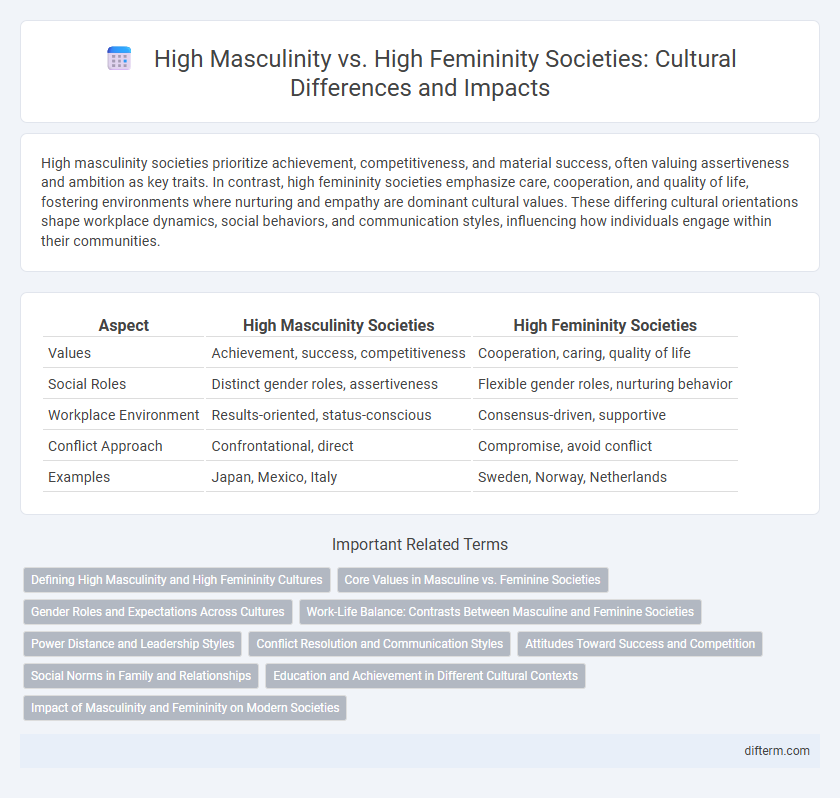High masculinity societies prioritize achievement, competitiveness, and material success, often valuing assertiveness and ambition as key traits. In contrast, high femininity societies emphasize care, cooperation, and quality of life, fostering environments where nurturing and empathy are dominant cultural values. These differing cultural orientations shape workplace dynamics, social behaviors, and communication styles, influencing how individuals engage within their communities.
Table of Comparison
| Aspect | High Masculinity Societies | High Femininity Societies |
|---|---|---|
| Values | Achievement, success, competitiveness | Cooperation, caring, quality of life |
| Social Roles | Distinct gender roles, assertiveness | Flexible gender roles, nurturing behavior |
| Workplace Environment | Results-oriented, status-conscious | Consensus-driven, supportive |
| Conflict Approach | Confrontational, direct | Compromise, avoid conflict |
| Examples | Japan, Mexico, Italy | Sweden, Norway, Netherlands |
Defining High Masculinity and High Femininity Cultures
High masculinity cultures prioritize competitiveness, ambition, and material success, emphasizing assertiveness and achievement as key societal values. In contrast, high femininity cultures value cooperation, care for others, and quality of life, fostering empathy and nurturing behaviors within social norms. These cultural dimensions influence workplace dynamics, communication styles, and gender role expectations across global societies.
Core Values in Masculine vs. Feminine Societies
High masculinity societies emphasize achievement, assertiveness, and material success as core values, fostering competition and ambition among individuals. In contrast, high femininity societies prioritize quality of life, caring for others, and cooperation, promoting empathy and community well-being. These fundamental value differences shape social roles, workplace dynamics, and interpersonal relationships within each cultural context.
Gender Roles and Expectations Across Cultures
High masculinity societies emphasize traditional gender roles where men are expected to be assertive, competitive, and focused on achievement, while women are often assigned nurturing and supportive roles. In contrast, high femininity cultures promote gender equality, with both men and women sharing responsibilities in caregiving and professional spheres, valuing cooperation and quality of life over competition. These differing cultural norms shape workplace dynamics, family structures, and social expectations, influencing individual behavior and societal development.
Work-Life Balance: Contrasts Between Masculine and Feminine Societies
High masculinity societies prioritize work achievement, competition, and success, often resulting in longer working hours and limited work-life balance. In contrast, high femininity societies emphasize quality of life, nurturing roles, and cooperation, promoting flexible work arrangements and a stronger focus on personal well-being. These cultural dynamics influence organizational policies, employee satisfaction, and societal values related to family and leisure time.
Power Distance and Leadership Styles
High masculinity societies exhibit a greater power distance, emphasizing hierarchical leadership styles where authority and competition dominate organizational culture. In contrast, high femininity societies prefer lower power distance, promoting participative and inclusive leadership that values collaboration and quality of life. These variations influence decision-making processes and interpersonal dynamics within workplaces, reflecting deep-seated cultural priorities toward power distribution and gender roles.
Conflict Resolution and Communication Styles
High masculinity societies prioritize assertive conflict resolution strategies, emphasizing direct communication and competitive problem-solving to establish dominance and achieve clear outcomes. In contrast, high femininity cultures favor collaborative approaches, valuing empathy, compromise, and consensus-building to maintain harmony and relational balance. Communication styles in masculine cultures tend to be more explicit and task-oriented, whereas feminine societies use indirect, relational, and context-sensitive language to resolve conflicts peacefully.
Attitudes Toward Success and Competition
High masculinity societies prioritize assertiveness, achievement, and competition as essential values, where success is often measured by status, material gains, and winning. In contrast, high femininity societies emphasize cooperation, quality of life, and nurturing behavior, viewing success through well-being, relationships, and work-life balance. These differing attitudes shape workplace dynamics, social interactions, and individual motivations within each cultural context.
Social Norms in Family and Relationships
High masculinity societies emphasize traditional gender roles within family and relationships, valuing assertiveness, competition, and material success as key social norms. High femininity societies prioritize cooperation, empathy, and nurturing behaviors, fostering egalitarian relationships with shared responsibilities between partners. These contrasting social norms influence communication styles, decision-making processes, and expectations for gender roles in domestic and social settings.
Education and Achievement in Different Cultural Contexts
High masculinity societies prioritize competition, achievement, and success in educational settings, often emphasizing performance, grades, and measurable outcomes to foster ambition and assertiveness. In contrast, high femininity cultures value cooperation, quality of life, and student well-being, promoting inclusive education methods and nurturing interpersonal skills alongside academic achievement. These differing cultural priorities significantly impact educational systems, influencing teaching styles, assessment criteria, and student motivation across global contexts.
Impact of Masculinity and Femininity on Modern Societies
High masculinity societies emphasize competition, achievement, and material success, fostering workplace environments driven by ambition and status. In contrast, high femininity cultures prioritize cooperation, quality of life, and care for others, promoting social equality and work-life balance. These differing values significantly influence organizational behavior, gender roles, and social policies in contemporary societies.
high masculinity vs high femininity societies Infographic

 difterm.com
difterm.com